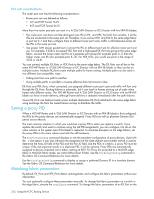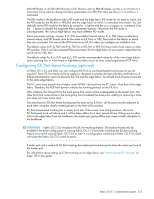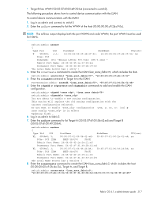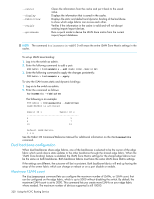HP StorageWorks 8/80 HP StorageWorks Fabric OS 6.1.x administrator guide (5697 - Page 316
Defining and naming zones, LSAN zones and fabric-to-fabric communications
 |
View all HP StorageWorks 8/80 manuals
Add to My Manuals
Save this manual to your list of manuals |
Page 316 highlights
address authority (NAA) field in the WWN to detect an FC router. LSAN zone enforcement in the local fabric occurs only if the administration domain member list contains both of the devices (local and imported device) specified in the LSAN zone. For more information, see "Managing administrative domains" on page 151. Defining and naming zones Zones are defined locally on a switch or director. Names and memberships, with the exception of hosts and targets exported from one fabric to another, do not need to be coordinated with other fabrics. For example, in Figure 33 on page 298, when the zones for Edge SAN 1 are defined, you do not need to consider the zones in Edge SAN 2, and vice versa. Zones that contain hosts and targets that are shared between the two fabrics need to be explicitly coordinated. To share devices between any two fabrics, you must create an LSAN zone in both fabrics containing the port WWNs of the devices to be shared. Although an LSAN is managed using the same tools as any other zone on the edge fabric, two behaviors distinguish an LSAN from a conventional zone: • A required naming convention. The name of an LSAN begins with the prefix "LSAN_". The LSAN name is case-insensitive; for example, lsan_ is equivalent to LSAN_, Lsan_, and so on. • Members must be identified by their port WWN because port IDs are not necessarily unique across fabrics. The names of the zones need not be explicitly the same, and membership lists of the zones need not be in the same order. To enable device sharing across multiple fabrics, you must create LSAN zones on the edge fabrics (and optionally on the backbone fabric, as well), using normal zoning operations to create zones with names that begin with the special prefix "LSAN_", and adding host and target port WWNs from both local and remote fabrics to each local zone as desired. Zones on the backbone and on multiple edge fabrics that share a common set of devices will be recognized as constituting a single multi-fabric LSAN zone, and the devices that they have in common will be able to communicate with each other across fabric boundaries. LSAN zones and fabric-to-fabric communications Zoning is enforced by all involved fabrics, any communication from one fabric to another must be allowed by the zoning setup on both fabrics. If the SANs are under separate administrative control, then separate administrators maintain access control. NOTE: If you are managing other switches in a fabric, it is recommended that you run the defZone --show command on your Fabric OS 5.1.0 and later switches as a precaution. Default zoning behavior in Fabric OS 5.1.0 and later operates differently compared to earlier versions of Fabric OS (2.x, 3.x v4.x and 5.0.1). For example, if you issue the defZone --noaccess command on a Fabric OS 5.1.0 or later switch, then default zoning configurations will be created on each switch in the fabric (2.x, 3.x, 4.x or v.0.1 switches). Fabric OS 5.1.0 and later switches do not indicate that a default configuration is enabled when you use the cfgShow or cfgActvShow commands. For more information about default zoning, refer to "Administering Advanced Zoning" on page 389. The following example procedure illustrates how LSANs control which devices can communicate with each other. The example procedure shows the creation of two LSANs (called lsan_zone_fabric75 and lsan_zone_fabric2), which involve the following devices: • Switch1 and the host in fabric75. • Switch2, Target A, and Target B in fabric2. • Switch1 is connected to the 4/256 SAN Director or DC Director with an FR4-18i blade using an EX_Port or VEX_Port. • Switch2 is connected to the 4/256 SAN Director or DC Director with an FR4-18i blade using another EX_Port or VEX_Port. • Host has WWN 10:00:00:00:c9:2b:c9:0c (connected to switch1). • Target A has WWN 50:05:07:61:00:5b:62:ed (connected to switch2). 316 Using the FC-FC Routing Service















